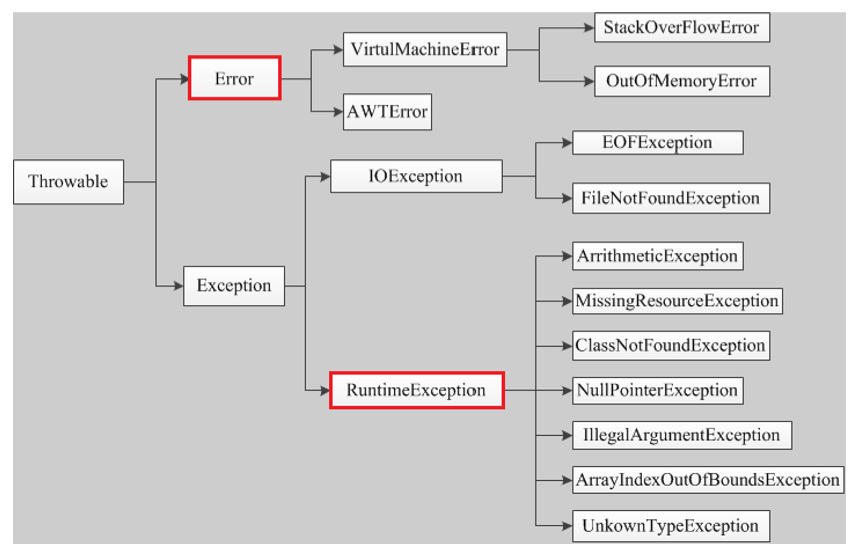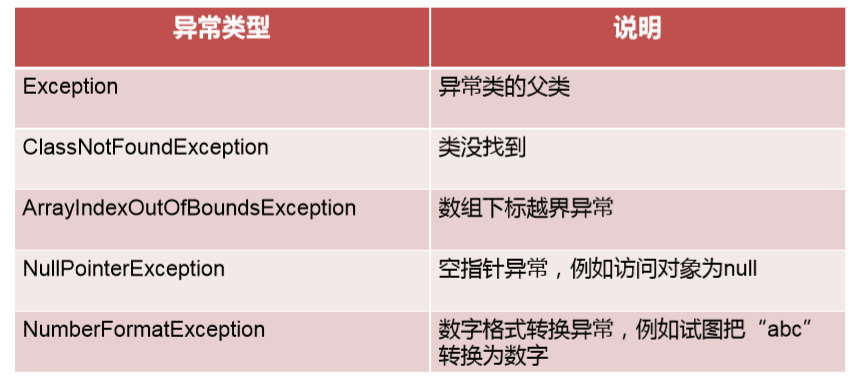一、异常
想想一下代码会发生什么?
public static void main(String[] args) { int a = 10; int b = 0; System.out.println(a/b); System.out.println("程序结束"); }
我们都知道,当分母不能为0,所以程序会报错,这是非编译错误。
1、异常的概念:
程序运行时,发生的不被期望的事件,它阻止了程序按照程序员的预期正常执行,这就是异常。
异常是程序中的一些错误,比如说,你的代码少了一个分号,那么运行出来的结果是提示是错误:Java lang Error ;如果你用System.out.println(11/0),那么你是因为你用了0做了除数,会抛出java.lang.Arithmetic Exception 的异常。
异常发生时,是任程序自生自灭,立刻退出终止,还是输入错误给用户?
Java提供了优秀的解决办法:异常处理机制。
2、异常体系结构
异常处理机制能让程序在异常发生时,按照代码的预先设定的异常处理逻辑,针对性的处理异常,让程序最大可能恢复正常并继续执行,且保持代码的清晰。

3、异常的分类
throwable类
Error 表示JVM异常,通常很少出现,也不需要程序员去处理
Exception
RuntimeException 运行时异常,(非检查异常)
IOException (检查异常,除了Error和RuntimeException之外的都是检查异常)
4、异常的使用
对于异常,我们有三种处理方法
1、捕获异常
try{
//可能出现异常的代码段
}catch(ExceptionName e){
//对异常进行处理的代码段
}finally{
//不管发不发生异常,都执行该模块下的内容
}
示例:
public static void main(String[] args) { int i = 10; int j = 0; try{ //首先程序进入try中,如果try中的代码没有出现异常,就执行try中的代码,然后打印程序结束 System.out.println(i/j); }catch(ArithmeticException e){ //当try中带代码出现异常,就会执行catch中的代码,然后打印程序结束 System.out.println("分母不能为0"); } System.out.println("程序结束"); }
控制台打印结果:分母不能为0
程序结束
2、声明异常
在方法中使用throws关键字声明异常
示例:
/** * 在方法上声声明一个异常 * @param args * @throws ArithmeticException */ public static void main(String[] args) throws ArithmeticException { System.out.println(11/0); }
3、抛出异常
try{
//可能出现异常的代码段
}catch(ExceptionName e){
throw new Exception();
}
示例:
/** * fun方法在main方法中调用,可以选择捕获异常,也可以选择继续往外抛异常 * @param args * @throws Exception */ public static void main(String[] args) throws Exception { //在这里继续把异常往外抛 fun(11,0); } /** * 在方法中声明创建一个异常,并往外抛异常 * @param i * @param j * @throws Exception */ public static void fun(int i ,int j) throws Exception{ try{ System.out.println(i/j); }catch(ArithmeticException e){ throw new Exception("分母不能为0"); } }
5、多重catch块
示例:
public static void main(String[] args) { try { String[] arr = null; System.out.println(arr[0]); FileInputStream io = new FileInputStream(""); }catch (FileNotFoundException e){ System.out.println(" 文件没找到 "); }catch(NullPointerException e){ System.out.println(" 对象为空 "); System. out.println(" 对象为空 "); } }
在安排catch语句的顺序时,首先应该捕获最特殊的异常,然后再逐渐一般化,即先子类后父类。
6、常见的异常类型
